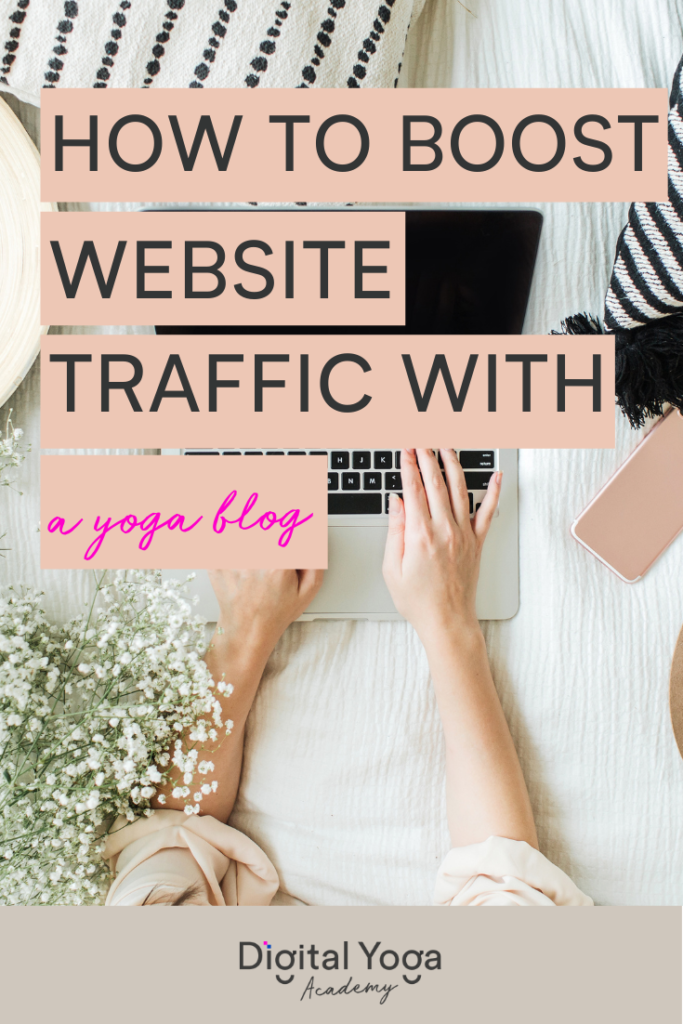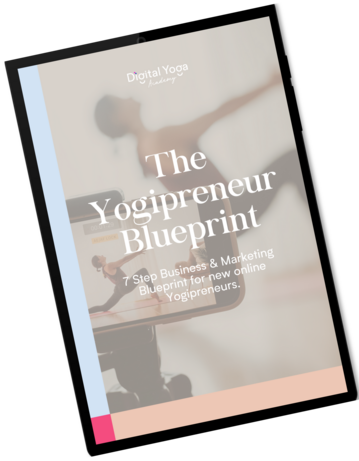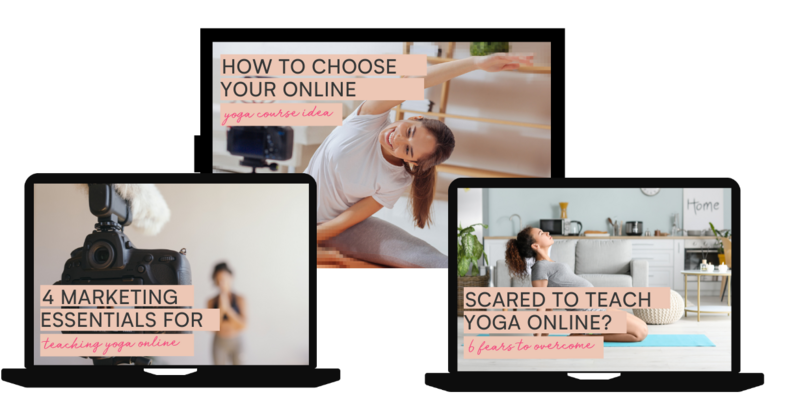Do you have a yoga blog?
These days there are so many experienced yoga teachers that standing out is becoming a challenge.
Truth is, if you’re not open to trying new tactics to share your message, it will become even more difficult to thrive and make a living from teaching yoga. Say hello to starting a yoga blog!
So if you’re asking yourself if you really need to start a yoga blog and spend time researching, writing and sharing, the answer is a big yes.
Starting a yoga blog is important because it’s such a critical piece for building an online presence and adding value and positioning yourself as an expert in your community.
There was a time when yoga teachers could just teach. But as more teachers go through their training, it’s becoming even more important to be visible online.
One of the ways to be truly visible online is through starting a yoga blog. And it’s actually super easy as all you’re doing is sharing your thoughts on the thing you love and know the most – yoga!
When Overwhelm Kicks In
Most people who start a yoga blog will write two or three articles and then quit and that’s often because the process can become so overwhelming.
When overwhelm kicks in, it’s easy to fall off the bandwagon because you’re teaching and doing everything else in your yoga business. In that case, starting a yoga blog just becomes a lesser priority.
That’s why it’s so important to have a plan. So you know what you’re going to write about when you put pen to paper.
It’s much easier than sitting at your laptop and thinking “ok, what am I going to write about today!”

Sharing outside of the studio
Think of your yoga blog as an extension of your yoga teachings. Perhaps something you wanted to share in class but didn’t have time.
Your yoga blog allows you to expand on your teachings or share new information you’ve learned.
You can help your students and support their practice through your written ideas. So think about what they want and need to learn more from you.
What message can you share with them but just in a different way – outside of the studio – on your yoga blog?
Understanding your why
Having a good understanding and connection to why you’re starting a yoga blog will help you to continue to feel inspired and motivated to work on your yoga blog.
There are many reasons why you should start a yoga blog from extending your reach around the world, networking and getting collaborations off the ground, to building your community and sharing more of you.
But today I want to focus on one of the key reasons why yoga blogging is so important. And that’s to boost traffic to your website.
Yoga marketing sales funnels
You can think of your yoga blog as the start of a marketing funnel. Think of it as a route into you and your yoga business and what you have to offer.
As you and other people share your yoga blog posts in new places, new people get to learn about you.
The challenge is to create engaging content for your yoga blog that creates desire with your readers. So that they want to work with you – and want you to be their yoga teacher.
And if you’re doing email marketing, those new people can then end up on your email list.
The more you blog, the better your website’s SEO will become. And the more people will find your website, contact you, sign up to your email list and book your classes!
As one of your primary goals is probably to attract more students to your classes, you should see your yoga blog as the start of that process. It should be a marketing funnel to grow your yoga business by attracting new students.

Making Google happy
Getting traffic to your website is hugely important if you want to get more email subscribers, more people to book your classes and in your community. But how do you actually make it happen?
Blogging really is KEY to growing your yoga business and to get more traffic (people!) from search engines (e.g. Google) to your website.
Yoga blogging helps to create more “crawl-able” pages than a typical website. That simply means that search engines like Google have more articles to rank in their search results.
They’re looking for regularly changing content on your website and will actually penalise you with a lower ranking if your site stays static.
So the more you can add to your yoga blog and create new, high-quality content, the higher your website will rank in relevant searches.
If you have a website with just a few pages – About, Class Schedule, Contact – there’s not a lot of information for search engines to “crawl”, rank and display in results.
No one is realistically searching for your About page. But if you have a yoga blog, there’s lots of extra information, words and different things that search engines can find and put into search engine results.
This gives you more opportunities to show up on Google and other search result sites.
Writing for search engines
You can’t write just any blog post and expect people to flock to it. You need to be strategic and ensure that you’re writing content that enough people are actually searching for online. So they find that blog post and end up browsing the other things you have on your website.
One of the ways to be more strategic around what you’re writing about is to understand how keywords work.
When you start to fully understand how keywords can help you and how to blog with search engines in mind, it makes blogging easier. Because it’s not random, there’s actually thought and the logic behind it.
You can start by asking yourself a few questions:
- What are your ideal students searching for online and how can YOU show up with the right answer?
- What can you create that solves the problem that your ideal students are experiencing?
- How can your yoga blog post help them with their yoga journey and questions they’re asking online?
What is a keyword?
A keyword is a word or phrase that someone types into a search engine like Google to look for something online.
This search will bring them to a piece of content on a website, such as a blog post.
Your goal is to figure out what your ideal student is typing into Google. Once you find it, you can use those exact yoga keywords in your blog posts and on your website. This helps to ensure that your blog posts come up when these keywords are used in a search.
Put simply…if you’re not using keywords that people are searching, how will they find you? They won’t.
You need to be using the types of phrases and words your target ideal students are searching for. So that they find your content and more people visit your website and discover you and your yoga offering.
The opportunity for you is showing up in the search results with a blog post that offers a solution to their problem.
Problem: “How to do yoga at home”
Solution: 5 Ways to Start a Home Yoga Practice Today!

Short-tail keywords vs long-tail keywords
How many people are really going into google and just typing YOGA?
This is what is known as a short tail keyword. It’s too general and results in lots of general and un-targeted search results. The likelihood of showing up in Google for the keyword YOGA is very slim as there are just too many websites out there with the word YOGA on.
Short-tail keyword: “Yoga”
Long-tail keywords, on the other hand, are a phrase that is more specific. There’s less competition and it’s likelier that you’ll attract more targeted traffic. And only results are shown that feature the phrase being searched.
Long-tail keyword: “Get started with yoga”
How to find relevant keywords
An easy way to research and find out what your ideal students are typing in Google is to use Google’s predictive text search facility.
Type in some ideas into Google and see what the predictive text comes up with. BUT make sure the things you type in are related to what you offer!
For example, if your niche is yoga for runners, you want to see what those people are typing in Google. Or if you focus on meditation for wellbeing, your search terms will want to include those keywords.
This is a great way to get started with keywords and to give you some ideas for what to write your blog posts on. Or even to create online classes and courses around what people are searching for online.
Type some initial ideas in, see what comes up, write down those ideas. And then try different combinations of words to get even more ideas.
Using keywords
Now that you have your keywords all set, you’re ready to add them into your content. And it’s important to put them in the right spot for maximum effect.
- In your blog post’s URL e.g. www.yogawithange.com/yoga-poses-for-pregnancy
- Blog post’s title (I recommend title begins with “How to” or a list “5 ways to….”
- In headlines within your post content (like H1, H2, H3 settings).
- The first few sentences within your post content.
- In 1-2% of your post content overall (you can calculate based on the total number of words in your post).
- In the image file name e.g. yoga-poses-pregnancy.JPG
Using these on-page SEO techniques and including your keywords within them, helps search engines to more accurately identify what information is on your web page. If they can more accurately assess what your page is about, then they can suggest it to more people when it is searched for.
Simply put, you are making it easier for people to find your website. And that will help to boost traffic to your yoga website.
I hope you found this helpful! Please add your comments and questions below.
Frequently Asked Questions
Why is it important to focus on website traffic for my yoga blog?
Boosting website traffic is essential for any blog, including those focusing on yoga. Increased traffic means reaching a wider audience, more engagement, and a higher potential for monetization through ads, affiliate marketing, or selling products and services.
What makes yoga blogs different from other blogs in terms of SEO?
While the basic principles of SEO apply to all blogs, yoga blogs have a specific target audience interested in wellness, health, and spirituality. Therefore, understanding the unique keywords, phrases, and topics that resonate with yoga enthusiasts will help optimize your content for better search visibility.
Which SEO techniques are most effective for a yoga blog?
Using relevant keywords like 'yoga poses', 'meditation techniques', or 'yoga benefits' consistently in your content, optimizing meta descriptions and titles, creating high-quality backlinks, and promoting on social media platforms where yoga enthusiasts gather can be particularly effective.
How important is content quality for driving traffic to my yoga blog?
Content quality is paramount. Engaging, well-researched, and authentic content not only attracts readers but also encourages them to share, comment, and return. High-quality content is also favored by search engines, which can improve your rankings and visibility.
Can I use videos and images to enhance my yoga blog's SEO?
Absolutely! Videos and images can make content more engaging. Ensure that you use relevant alt text for images and optimize video descriptions and titles with keywords to enhance SEO. Also, having yoga demonstration videos or illustrative images can be particularly valuable for readers.








